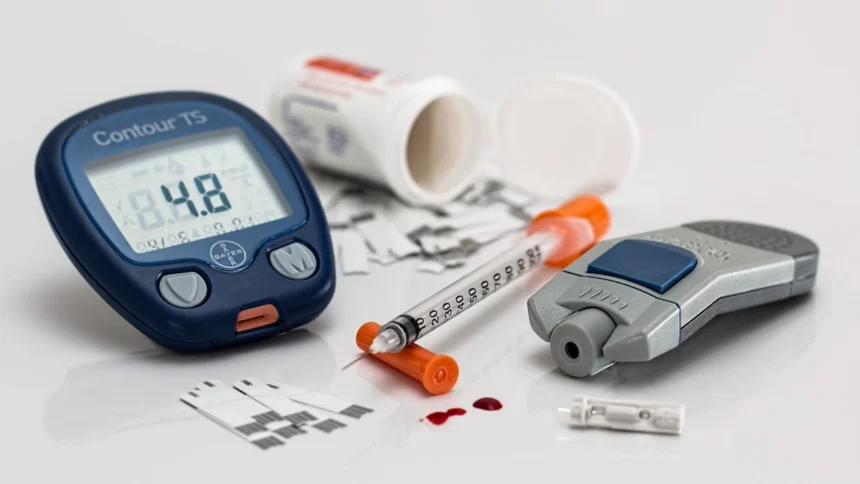Introduction: The Diabetes Silent Killer
Diabetes has earned the reputation of a silent killer because it can develop silently for years, often without noticeable symptoms, while causing progressive damage to organs. Globally, more than 530 million adults live with diabetes, but a large portion remains undiagnosed, unaware of the serious risks they face. The disorder interferes with the body’s ability to regulate blood sugar, which can silently affect the heart, kidneys, eyes, nerves, and blood vessels. Understanding the risks, recognizing early signs, and implementing preventive or treatment measures are crucial steps to reduce long-term health consequences.
What Diabetes Does to the Body
Diabetes disrupts the body’s natural regulation of glucose due to problems with insulin production or its effectiveness. In type 1 diabetes, the immune system attacks insulin-producing cells, leaving patients dependent on daily insulin therapy. Type 2 diabetes, the more common form, occurs when the body develops resistance to insulin or cannot produce enough. Gestational diabetes arises during pregnancy, creating potential risks for both mother and child. Regardless of type, uncontrolled diabetes silently damages organs over time, increasing the risk of life-threatening complications if left unmanaged.
The Silent Progression of Diabetes
One of the most concerning aspects of diabetes is its silent nature. Many individuals remain unaware of their condition for years, as blood sugar levels gradually rise without causing obvious symptoms. This silent progression contributes to irreversible organ damage, including cardiovascular issues, kidney failure, vision impairment, and nerve damage. Patients often first learn about their diabetes only after severe complications arise. Early detection through regular screenings can prevent these outcomes and is key to reducing the global burden of the disease.

Global Impact of Diabetes
Diabetes is a worldwide health challenge affecting populations across every continent. Rapid urbanization, sedentary lifestyles, unhealthy diets, and aging populations contribute to the rising prevalence of type 2 diabetes. According to the World Health Organization, approximately one in ten adults globally has diabetes, and numbers continue to increase. Low- and middle-income countries face additional challenges, including limited access to healthcare, lack of awareness, and delayed diagnosis. The condition not only affects individual health but also places a significant burden on healthcare systems worldwide. https://diabetes.org/about-diabetes
Recognizing Symptoms Early
Although diabetes is a silent killer, subtle signs may indicate its presence. Increased thirst, frequent urination, unexplained weight loss, fatigue, blurred vision, and slow-healing wounds are often overlooked, yet they signal that blood sugar levels are elevated. Numbness or tingling in the extremities may also occur due to nerve damage. Early recognition of these symptoms and timely medical evaluation can prevent long-term organ damage and improve quality of life.
Understanding Risk Factors
Several factors contribute to the development of diabetes. Genetics plays an important role, as family history can increase susceptibility. Lifestyle factors, including poor diet, obesity, and physical inactivity, significantly elevate risk. Age also influences susceptibility, particularly for type 2 diabetes. Other health conditions, such as high blood pressure and high cholesterol, can further increase the likelihood of developing diabetes. Awareness of these risk factors allows individuals to adopt preventive strategies and reduce their chances of contracting the disease.
Long-Term Complications
If diabetes remains uncontrolled, it can lead to serious complications. Cardiovascular diseases, including heart attacks and strokes, are common outcomes due to damage to blood vessels. Kidney disease may progress to renal failure, while diabetic retinopathy is a leading cause of vision loss worldwide. Nerve damage, or neuropathy, can result in chronic pain and increase the risk of infections or amputations. These complications highlight why diabetes is often referred to as a silent killer, capable of causing devastating health consequences without obvious warning signs.
Diagnosis and Screening
Healthcare providers use specific tests to detect diabetes early, even when symptoms are absent. Blood glucose levels, fasting glucose tests, and Hemoglobin A1C measurements are common methods used to assess long-term glucose control. Annual screenings are recommended for adults, particularly those with risk factors such as obesity, family history, or high blood pressure. Early diagnosis allows for timely intervention, including lifestyle modifications and medical treatment, reducing the risk of complications.
Treatment Approaches
Managing diabetes requires a comprehensive approach tailored to each individual. Medications, including insulin for type 1 diabetes and various oral agents for type 2, are essential to regulate blood sugar. Lifestyle changes, including maintaining a balanced diet, regular physical activity, and weight management, are equally critical. Monitoring blood sugar regularly helps patients and healthcare providers track progress and adjust treatment as needed. Psychological support also plays a role in helping individuals adhere to treatment plans and manage the challenges of living with a chronic disease.
Prevention Strategies
Preventing diabetes relies heavily on proactive lifestyle choices. Maintaining a healthy weight, engaging in regular physical activity, and following a diet rich in whole foods, vegetables, and fruits can reduce risk. Avoiding excessive sugar and processed foods further supports blood sugar regulation. For individuals with a family history of diabetes or other risk factors, early screening and monitoring are vital. Population-level initiatives focusing on education, awareness, and lifestyle interventions are essential to curb the global rise of diabetes.
Living with Diabetes
With proper management, people living with diabetes can lead fulfilling lives. Adherence to prescribed medications, structured diets, and exercise routines are key components. Regular checkups ensure complications are identified and treated early. Access to education programs, counseling, and support groups helps patients cope with the emotional and psychological challenges of managing a chronic illness. These comprehensive care strategies reduce long-term risks and improve overall quality of life.
Global Public Health Perspective
Diabetes represents a significant public health challenge worldwide. Its prevalence continues to rise, and the associated complications burden healthcare systems and societies. Governments and health organizations are promoting awareness campaigns, preventive screenings, and community-based interventions to reduce the disease’s impact. Addressing diabetes proactively not only improves individual health outcomes but also reduces the broader economic and healthcare burden.

Research and Future Directions
Ongoing research focuses on understanding the causes of diabetes, improving treatment options, and preventing complications. Innovations include new medications, advancements in insulin delivery, and studies on genetic and environmental factors. Public health initiatives aim to reduce risk through education, early detection, and lifestyle interventions. Collaborative global efforts are essential to controlling the diabetes epidemic and minimizing its deadly impact.
Conclusion
Diabetes remains a silent killer, threatening millions of lives worldwide. Early detection, adherence to treatment, lifestyle management, and preventive measures are critical to reducing its devastating health consequences. Awareness, education, and proactive healthcare interventions can help mitigate the global burden of diabetes and improve quality of life for affected individuals.




